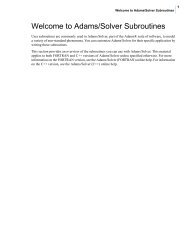You also want an ePaper? Increase the reach of your titles
YUMPU automatically turns print PDFs into web optimized ePapers that Google loves.
<strong>ICAM</strong> <strong>Virtual</strong> <strong>Machine</strong> ® Version 19.0 <strong>Virtual</strong> <strong>Machine</strong> Reference, Menu Bar<br />
Simulation»Stock/Fixtures/Part (CeRun & Gener only)<br />
Select the top entry in the navigator to see list of objects for the selected type. Select New and<br />
then New Stock (or New Part or New Fixture in the pop-up context menu that will appear) to<br />
create a new object. The object‟s name is used by VM when reporting collision diagnostics. The<br />
object‟s current axis defines the stock axis (or mounting point) where the object will be attached<br />
to the machine model at the start of the program. <strong>Machine</strong> models with multiple tables or pallets<br />
may define multiple stock axes. Click on an entry in the table to change the object‟s name, its<br />
default axis (used when the program starts) or the current axis (the association in force at this<br />
point in the program). Setting the stock axis value to “None” removes it from the simulation, but<br />
not from the list of objects. You can select one or more objects in the right hand list and press the<br />
Delete button to completely remove them.<br />
Each object can consist of one or more<br />
physical components, which are listed<br />
when you select an object name in the left<br />
hand list box, or when you select an object<br />
in the right hand object list and press the<br />
Modify button. Each component of an<br />
object can be given a name, which will be<br />
reported during collision diagnostics (e.g.,<br />
“Stopper”). Fixture components can be<br />
tagged as machinable or not. Part components<br />
are never machinable; stock components<br />
are ignored for collision testing<br />
purposes.<br />
Select the New button to add a new component. The following component types can be added:<br />
� Cube: Defines a rectangular region given the XYX coordinates of one corner and the<br />
length, width and height (ΔXYZ).<br />
� Cylinder: Defines a cylindrical or conical region given an XYZ coordinate of the center,<br />
an initial radius, a final radius and the overall length. The surface of the cylinder is approximated<br />
by a number of faces, which can be specified. The light rendering at the edges<br />
between faces can be set smooth or sharp, allowing shapes like a hexagon to be<br />
defined.<br />
� Cone: Defines a conical region given an XYZ coordinate of the center, an initial radius, a<br />
final radius and the overall length. The Cone and Cylinder definitions are identical; they<br />
differ during construction only.<br />
� Import STL: Imports an STL file relative to a specified XYZ location in the model.<br />
Components are created interactively in the simulation window. The various Hide… check<br />
boxes can be selected to reduce the visual clutter in the simulation window during component<br />
creation. When a component is being created, its type and required parameters are listed at the<br />
bottom of the simulation window. You can enter the parameters using the keyboard, or you can<br />
move the mouse to an appropriate position and click the left-mouse button. Each click of the<br />
mouse can supply values for one or two parameters. You can change the camera position,<br />
standard view or user-defined viewpoint at any time. Use the Tab key and Shift-Tab key to move<br />
forwards and back through the required parameters to make changes. When creating new objects<br />
80 <strong>ICAM</strong> Technologies Corporation – Proprietary















